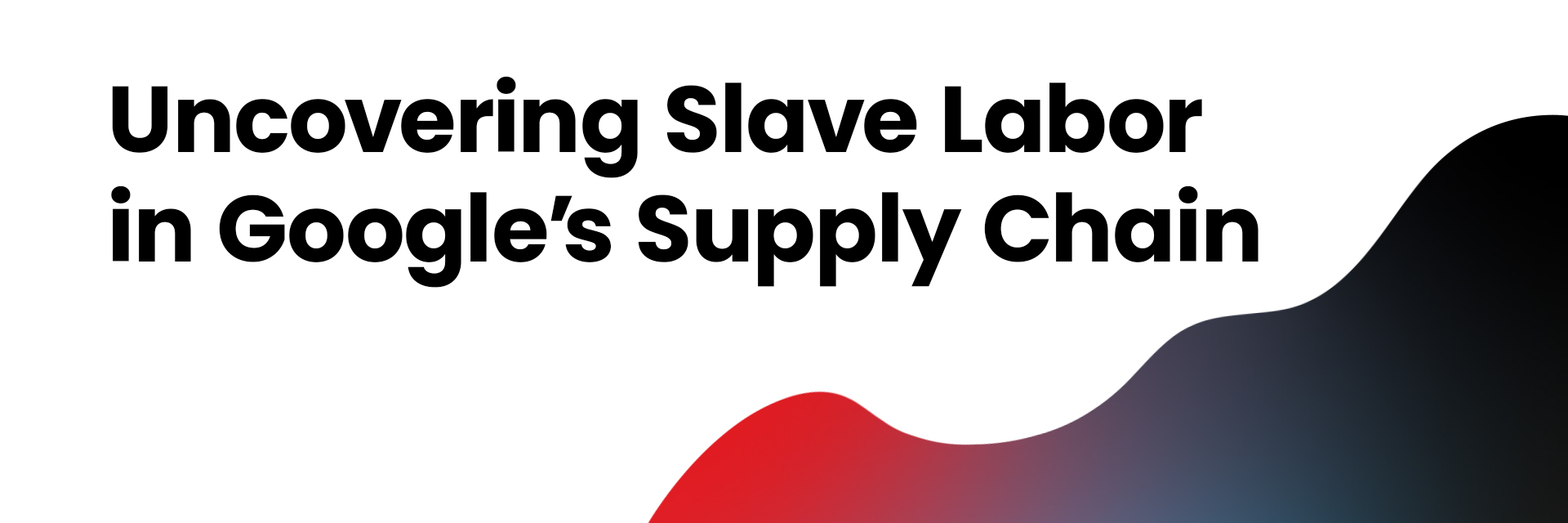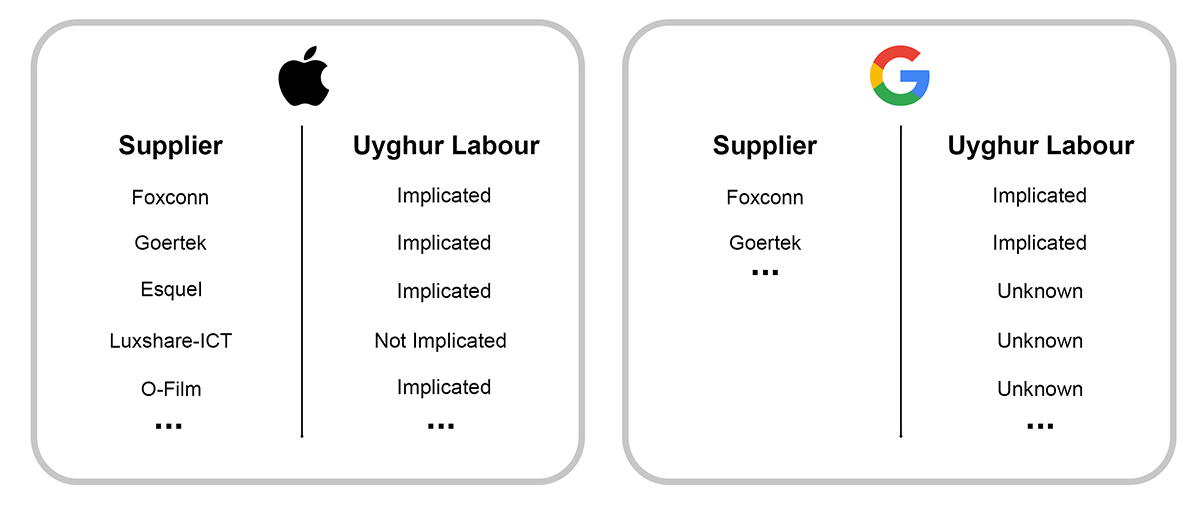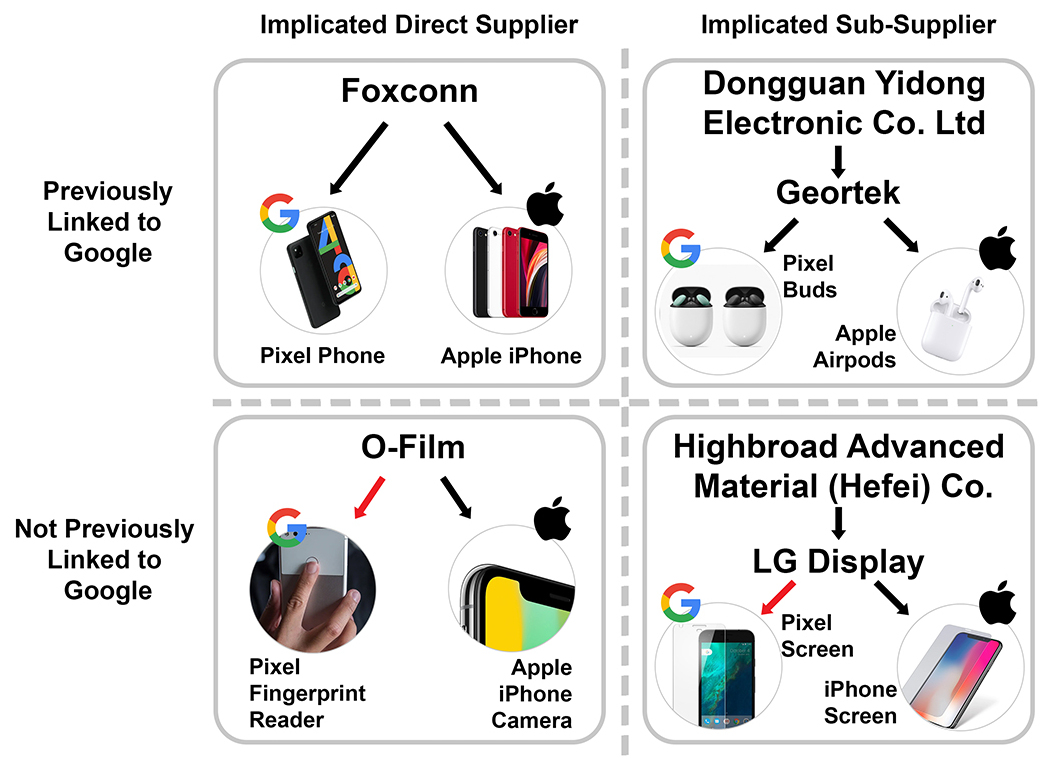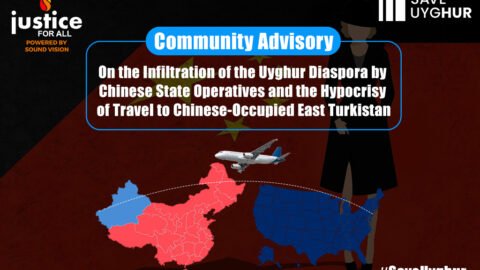Community Advisory Chinese State Surveillance of the Uyghur Diaspora and Misuse of Travel to Occupied…

Uncovering Slave Labor in Google’s Supply Chain
Abstract
The supply chain of many household technology companies has recently been linked to the human rights abuses against the Uyghur population in East Turkestan. Despite engaging with many of the same suppliers as other tech companies, Google has received much less criticism. This is because Google, unlike Apple, does not publicly publish its supplier list – a fact that has inhibited investigators from connecting Google to the implicated suppliers. In this article, we provide examples that demonstrate how, for the same supplier, Apple was implicated while Google escaped blame. Additionally, we dissect each company’s auditing process to uncover why there is a clear disconnect between external audit and internal self-reported audit reports.
We find that a lack of transparency in the auditing process and results, conflicts of interest created when companies fund human rights organizations, and a lack of disciplinary action taken by companies towards complicit suppliers all contribute to an ineffective audit process. As such, recommendations have been made to strengthen current legislative efforts that pressure American and Chinese businesses to eliminate slave labor from their supply chains.
Background
The Australian Strategic Public Policy Institute revealed that the supply chains of major brands are involved in the abuse of up to 2 million Uyghur Muslims[1] in East Turkestan, as part of a larger pattern of forced labor and human rights violations by China against occupied and other minority citizens[2]. The actions of the Chinese state have been described as genocide by former Secretary of State Mike Pompeo[3] and have been determined to meet the UN definition of genocide by researchers[4]. Some of the reported human rights abuses include, but are not limited to:
- Forced transportation from their homes and families in Xinjiang to factories throughout China.
- Being subjected to threats of arbitrary detention against themselves or their families.
- Being monitored by digital surveillance and security personnel, e.g. “Every 50 Uyghur workers are assigned one government minder and are monitored by dedicated security personnel.”
- A ban on religious practices, e.g. “The police regularly check their dormitories…if a Quran is found, the owner will be sent back to the ‘re-education camp’ for 3–5 years.”
- Excessive hours, e.g. “mandatory after-work Mandarin language classes and political indoctrination sessions that are a required part of job assignments.”
- Abusive working conditions and “military-style management”, e.g. advertisements for Uyghur labor include “can withstand hardship” as a selling point.
Uncovering Slave Labor in Google’s Supply Chain
It is no surprise to those familiar with the tech industry that, since its inception, Google’s hardware division has closely followed in Apple’s footsteps when it comes to major product decisions. When Apple decided to remove the headphone jack, add a fingerprint sensor, and later add a facial recognition feature to unlock phones, Google began releasing the same features to its phones, just one step behind[5]. However, Google has been following Apple not only in its product decisions, but also with regards to its supply chain decisions.
- The Pixel phone, Google’s competitor to the iPhone, shares the same contract manufacturer: Foxconn[6]. Foxconn is the largest electronics manufacturer in the world, and has been directly involved in the “Xinjiang Aid” scheme and using forced Uyghur labor to work in its factories[7].
- The Pixel Buds, Google’s competitor to AirPods, are manufactured by the same Chinese company: Goertek[8]. There has been evidence of Goertek’s subcontractor, Dongguan Yidong Electronic[9] Co. Ltd, using forced Uyghur labor since as early as May 17, 2018
From the ASPI report, the overlap between Google and Apple’s corrupted supply chains appears to stop with these two suppliers. Unfortunately, the writers missed out on many additional connections because of a lack of transparency by Google. They were able to do their research on Apple because, although it is not perfect, it has made progress by making its supplier list publicly available for researchers and NGOs to identify human rights abuses[10]. We should expect that Google, whose mission statement is to make the world’s information “universally accessible and useful[11]”, would do the same. However, Google has never published a supplier list[12] and has made no public intention of doing so. The lack of a supplier list makes it difficult for NGOs and researchers to identify human right abuses[2] and thereby shift the brunt of media attention for corrupted supply chains to companies which do, like Apple.

Instead, any supply chain connections need to be piecemealed from disconnected sources of information (e.g. supplier websites listing Google as their customer or Chinese media reports). This has resulted in missed connections, as demonstrated below
- Many sub-components for both Apple and Google were manufactured by the same Chinese company: O-Film. At the end of 2017, the ASPI reported that over 1,000 Uyghur workers were employed at O-film factories[13]. This is an example where Apple was implicated for being tied to O-Film as an end customer, while Google was not. However, O-Film produced the fingerprint sensor for multiple generations of the Pixel[14].
- Displays for both Apple and Google products have often used panels from LG Display[15]. LG Display sources its display components from Highbroad Advanced Material (Hefei) Co. The ASPI report connected Hefei to the employment of 1,044 Uyghur workers[16]. Once again this is an example where Apple was implicated as an end customer, whereas Google was not.
Due to the difficulty in identifying Google’s suppliers, there are likely even more connections between Google’s hardware and Uyghur slave labor that were missed. The issue of identifying suppliers is compounded by the complex web of sub-suppliers used in Chinese industry. In the case of Hefei, for example, they are a sub-supplier which Congress has since added to the Entity List – a list of companies that the U.S. is now banned from doing business with[17]. However, Google and Apple tend to supply indirectly from Hefei through intermediary suppliers such as LG Display and BOE, and these direct suppliers are not on the entity list. This cripples the effectiveness of the Entity List, as companies can work via intermediary suppliers whenever necessary and are expected to self-monitor their downstream impact
Knowledge of the overlap between Google and Apple’s corrupted supply chain is limited by Google’s lack of transparency

Diagram of Google and Apple’s supplier and sub-supplier overlap. By not publicly disclosing their supply chain, Google is able to evade responsibility, despite using many of the same suppliers used by Apple. While some suppliers were linked to Google through the ASPI report, others are shown here as new connections previously unknown to human rights groups.
Google’s Fallible Audits and Inaction
Without a publicly available supplier list, we rely heavily on Google to organize and conduct its own supply chain audits and assessments. However, Google’s ability to effectively assess its suppliers is put into question by the published results of previous audits. Google’s 2019 Supply Chain Responsibility Report[18] states that 100% of its audited suppliers passed its requirements for “humane treatment” and “freedom of association.” A 100% rating in these categories is highly suspicious given what is now clear about the labor schemes of Google’s Chinese supply chain in that reporting year. Although scores were somewhat lower in other categories (e.g. 99.46% in “non-discrimination” and 96.74% in “freely chosen employment”), these numbers still paint a fairly positive picture. It’s important to note that Google has a supply chain[19] of over 1,000 suppliers in over 70 countries which includes much more than its hardware division, such as cloud infrastructure suppliers, global office construction companies, employee amenities and services, etc
Regional hardware suppliers with serious labor rights violations, as demonstrated by forced Uyghur labor in China, still allow for a 99.46% score in “non-discrimination” since these violations are masked by the global average. For those categories in which Google rated itself at 100%, there are a few possible explanations:
- Google’s auditing procedure is inadequate and was unable to catch the many human rights violations that have been ongoing for several years.
- Google’s auditing process does not assess suppliers further down its supply chain, although this wouldn’t explain how Foxconn passed its requirements for humane treatment[20] (a direct supplier with a record of many consecutive years of human rights violations)
- Google’s auditing process found issues, but either due to negligence or bad faith, it did not adequately report on the issues discovered.
Each of these potential explanations suggest that Google was not successful in doing its due diligence. The clear disconnect between reality and reported results raises questions about the auditing process used by technology companies. As of 2022, Google’s Supply Chain Responsibility Report[21] no longer includes any figures at all, another reduction of public information which enables the evasion of criticism. Rather, to indicate successful progress against their responsibility metrics, they put a thoroughly uninformative green dot. The following list highlights some of the issues with this process:
Reporting Performance Metrics
Although there is some commonality in how audits are conducted across companies[22], the scoring system and reporting language can differ and it is ultimately up to the individual company’s discretion. Without standardized auditing criteria and reporting formats, businesses can tweak their phrasing and charts in ways that portray them in the best light possible while ignoring the grim reality of their supply chains. For example, the extent of forced labor in Chinese factories can be masked by combining their audit results[23] with those from jurisdictions with respect for human rights.
Performing the Audit
There are also inconsistencies in which organizations conduct the audits. Apple describes a mix of third party and “Apple-managed audits”[24], with the selection of suppliers to be audited being a decision that is informed by internal teams, various NGOs, and external stakeholders. In contrast, Google describes a much stronger focus on third-party audits[25]. However, these third parties are usually not identified which makes it impossible to assess whether they can be trusted to conduct honest, impartial, and effective audits.
Funding and Conflicts of Interest
Another concern with the auditing process is the fact that both Google and Apple donate to and fund organizations involved in assessing and combating human trafficking, which leads to a conflict of interest. According to a statement that Apple released[26] in 2018, the company proudly explains its support for a variety of human rights organizations. For example, they state “…we funded an international expert and an organization specializing in land rights to conduct initial research for a human rights impact assessment…The HRIA results informed Apple’s decisionmaking with respect to the location of the potential project.” While potentially well-intentioned, there is a clear conflict of interest when the organizations tasked with assessing Apple’s impact on human rights also rely on money for Apple to fund their research. Similarly, there is the example of Google donating $3,000,000 to support anti-human trafficking[27] efforts by various NGOs. Such donations could have profound implications on the survival of an NGO, which inevitably leads to a conflict of interest.
State Interference in Audits
A recent report published[28] by the Congressional-Executive Commission on China highlighted that “traditional third-party audits are highly unlikely to be effective.”[29] This is due to heavy surveillance in East Turkestan and government intervention that hampers auditors from engaging in their work. In the face of concerted state-action, ensuring that supply-chains inside China, especially East Turkestan, are humane is extremely difficult.
Following Through on Disciplinary Actions
The purported disciplinary actions to be implemented by companies, after violations are found in an audit, are not necessarily enforced. Per Apple’s Supply Chain Report, “If a supplier is unwilling, or unable, to correct a Core Violation, or in the event of a repeat Core Violation, the supplier is removed from Apple’s supply chain.”[30] Similarly, Google has released a statement about how it will prohibit business engagement with a supplier or sub-suplier “that engages in modern slavery.”[31] However, the lack of legally binding consequences means that companies can take as many or as few corrective actions as they see fit. Most likely, it will be a strategic business decision. For example, when dealing with Foxconn, the manufacturer currently producing iPhones and Pixel phones, it would make little business sense for either Google or Apple to decrease production volumes. Given how many workplace violations Foxconn has been accused of in the past decade, and the fact that both Google and Apple continue to work with them, it would not come as a surprise if Foxconn management now saw ethics code violations as an empty threat. Without legally binding directives or incentives, there is little motivation for these companies to follow through with disciplinary actions.
In order to satisfy their obligation to shareholders, large technology companies are driven to cut costs at every opportunity. This includes searching for the cheapest source of labor, at the risk of using slave labor. Years of corporate commitments to end modern slavery have led to small improvements by Apple and Google, but only insofar as there was minimal risk to company operations or profits. On the other hand, when threatened with a significant increase in business costs, as a result of increased tariffs on Chinese goods, both companies started rapidly developing new manufacturing bases in other countries. Unfortunately, such speed and decisiveness was nowhere to be seen when confronted with human rights concerns. Unsurprising, as fighting modern slavery isn’t profitable.
Recommendations
Below, we list a variety of other measures which we believe will help enact justice.
Recommendations to Google
- Adopt UN Guiding Principles on Business and Human Rights, namely put in place:
- A statement of their policy commitment to respect human rights;
- A human rights due diligence process to:
- Assess their actual and potential human rights impacts;
- Integrate the findings and take action to prevent or mitigate potential impacts;
- Track their performance;
- Communicate their performance;
- Processes to provide or enable remedy to those harmed, in the event that the company causes or contributes to a negative impact.
- Annually publish and make accessible Google’s supplier list
- Commit to making supplier auditing criteria and audit outcomes publically available
- Divest from business contracts with suppliers implicated in human rights abuses.
- Shift supply sources outside China.
- Require clean supply chains as a requisite for all business with suppliers going forward.
Recommendations to Congress
- Expand the Uyghur Forced Labor Prevention Act to regulate goods from Xinjiang such that it applies to all other provinces in China.
- Require that American businesses publicly publish their supplier lists.
- Develop legally-binding corrective actions for companies to take when a supplier has been identified as utilizing forced labor.
- Take steps to minimize the conflicts of interest created by corporate philanthropic efforts in the human rights arena. This could mean either: form an independent body responsible for auditing companies’ supply chains and enforcing compliance measures, or establish a specific budget line for NGOs which audit the supply chains of American companies.
- Standardize the auditing procedure (onsite interviews with management and employees, supplier documentation reviews, virtual surveys, etc.), scoring systems for audit results, and corrective action plan requirements. This is to enable effective evaluation and comparison of companies’ performance.
- Adopt legislation requiring all publicly traded companies to publicly disclose their use of forced labor in supply chains in their mandatory Securities and Exchange Commission (SEC) disclosures – as was done with conflict minerals in Section 1502 of the Dodd Frank Act.
Recommendations to US Administration
- Instruct the Office of Foreign Assets Control (OFAC) to continue to place sanctions against China or against those affiliated with forced labor businesses in China.
- Urge the SEC to require publicly listed companies to disclose use of forced labor similar to Section 1502 of the Dodd Frank Act.
- In addition to marking of origin requirements, CBP should require items produced with forced labor to explicitly state as such.
Recommendations to Human Rights Organizations
- Remove the reliance on donations from companies which are audited by NGOs by seeking funding from sources that won’t result in a conflict of interest.
- Demand Google adopts the recommendations noted above.
- Push manufacturers and suppliers to submit to transparent and comprehensive audit processes.
Recommendations For United Nations
- Adopt the UN Guiding Principles on Business and Human Rights as binding international law
- Establish a UN Commission of Inquiry into human rights abuses occurring in East Turkestan (XUAR)
- Refer Chinese government officials complicit in human rights abuses to the International Criminal Court for investigation and possible prosecution
- Develop a standardized auditing procedure for manufacturing supply lines.
[1] Westcott, B. (2020, March 12). New US bill could ban imported Chinese goods from Xinjiang amid forced labor concerns. CNN. (Archived URL: http://archive.vn/u0gPo)
[2] Xu, V. X., Cave, D., Leibold, J., Munro, K., & Ruser, N. (2020). Uyghurs for sale (Working paper). Australian Strategic Policy Institute. (Archived URL: http://archive.vn/g9XCr)
[3] Chappell, B. (2021). Pompeo Accuses China Of Genocide Against Muslim Uyghurs In Xinjiang. NPR. (Archived URL: https://archive.vn/odhzX)
[4] Zenz A. (2020). China’s Own Documents Show Potentially Genocidal Sterilization Plans in Xinjiang. Foreign Policy. (Archived URL: https://archive.vn/yMFVC)
[5] Simons, H. (2019, October 19). 5 bad ways Google is copying iPhones past and present with Pixel 4. Android Authority. (Archived URL: http://archive.vn/uP1yF)
[6] This was published in two separate pieces in Android Headlines and Bloomberg for the Pixel and iPhone respectively. — Maxham, A. (2018, October 11). Google Pixel 3 Built By Foxconn Instead Of HTC Or LG. Android Headlines. (Archived URL: http://archive.today/JJ0MJ) — Gurman, M. (2019, September 9). Apple, Foxconn Broke a Chinese Labor Law to Build Latest iPhones. Bloomberg. (Archived URL: http://archive.today/PBGkX)
[7] Xu et al., supra note 2
[8] This was published in two separate pieces in 9to5Google and Patently Apple for the Pixel Buds and AirPods respectively. — Li, A. (2017, October 19). FCC filing for Google Pixel Buds reveals Chinese maker also behind PlayStation headphones. 9to5Google. (Archived URL: http://archive.today/6Gy1Z) — Purcher, J. (2019, July 17). A 2018 Rumor of GoerTek moving AirPod Production to Vietnam is Confirmed today as Apple Reportedly begins Production Tests. Patently Apple. (Archived URL: http://archive.today/VXdQH)
[9] Xu et al., supra note 2
[10] Apple Supplier Responsibility 2019. (2019). Apple. (URL: https://www.apple.com/supplier-responsibility/pdf/Apple-Supplier-List.pdf)
[11] Google, About Google, Our Culture & Company News. (n.d.). Retrieved October 02, 2020, from https://about.google/ (Archived URL: http://archive.today/Cup7V)
[12] 2017 Company Report Card (Greenpeace Guide to Greener Electronics). (2017). Greenpeace. (URL: https://www.greenpeace.org/usa/wp-content/uploads/2017/10/GGE2017_Google.pdf )
[13] Xu et al., supra note 2
[14] FPC Fingerprint Sensors Power Google Pixel 3a’s Biometrics. (2019, May 10). Find Biometrics. (Archived URL: http://archive.today/F83pz) — Fingerprints. (2016, January 6). FPC and O-Film collaborate on touch fingerprint sensors [Press release]. Retrieved October 2, 2020, from https://www.fingerprints.com/2015/01/06/fpc-and-o-film-collaborate-on-touch-fingerprint-sensors/ (Archived URL: http://archive.vn/4JIOe)
[15] This was published in two separate pieces in 9to5Google and 9to5Mac for Google and Apple respectively. — Li, A. (2018, October 17). Teardown surprisingly reveals LG display on smaller Google Pixel 3. 9to5Google. (Archived URL: http://archive.vn/P3qNW) — Lovejoy, B. (2020, May 27). LG gets orders for 20M OLED iPhone screens this year, ending Samsung monopoly. 9to5Mac. (Archived URL: http://archive.vn/blRTN)
[16] Xu et al., supra note 2
[17] UFLPA Entity List. (Retrieved May 5th, 2023; Archived URL: https://web.archive.org/web/20230530010753/ https://www.dhs.gov/uflpa-entity-list)
[18] Responsible Supply Chain Report (Rep.). (2019). Google. (URL: https://services.google.com/fh/files/misc/google_2019-rsc-report.pdf)
[19] Google, supra note 18
[20] Condliffe, J. (2018, June 11). Foxconn Is Under Scrutiny for Worker Conditions. It’s Not the First Time. The New York Times. (Archived URL: http://archive.vn/Hm47i)
[21] Google Supplier Responsibility Report 2022 (2022). Google. (Archived URL: https://web.archive.org/web/20230417044627/ https://www.gstatic.com/gumdrop/sustainability/google-2022-supplier-responsibility-report.pdf)
[22] This is the standard operating procedure for both Google and Apple. — Google, supra note 18 — Supplier Responsibility – 2019 Progress Report (Rep.). (2019). Apple. (URL: https://www.apple.com/supplier-responsibility/pdf/Apple_SR_2019_Progress_Report.pdf)
[23] China 2019 (Rep.). (2019). Amnesty International. (Archived URL: https://archive.vn/5Ec6u)
[24] Apple, supra note 22
[25] Google, supra note 18
[26] 2018 Statement on Efforts to Combat Human Trafficking and Slavery in Our Business and Supply Chains (Rep.). (2018). Apple. (URL: https://www.apple.com/supplier-responsibility/pdf/Apple-Combat-Human-Trafficking-and-Slavery-in-Supply-Chain-2018.pdf)
[27] PND by Candid. (2013, April 11). Google Awards $3 Million to Combat Human Trafficking [Press release]. Retrieved from https://philanthropynewsdigest.org/news/google-awards-3-million-to-combat-human-trafficking (Archived URL: http://archive.today/8zSjy)
[28] CONGRESS. (2020). Congressional-Executive Commission on China. Staff Research Report. Global Supply Chains, Forced Labor, and the Xinjiang Uyghur Autonomous Region. (URL: https://www.cecc.gov/sites/chinacommission.house.gov/files/documents/CECC%20Staff%20Report%20March%202020%20-%20Global%20Supply%20Chains%2C%20Forced%20Labor%2C%20and%20the%20Xinjiang%20Uyghur%20Autonomous%20Region.pdf)
[29] Amy K. Lehr and Mariefaye Bechrakis (2019), “Connecting the Dots in Xinjiang: Forced Labor, Forced Assimilation, and Western Supply Chains,” Center for Strategic and International Studies. (URL: https://www.csis.org/analysis/connecting-dots-xinjiang-forced-labor-forced-assimilation-and-westernsupply-chains)
[30] Apple, supra note 22
[31] Policy Against Modern Slavery (Rep.). (2020). Google. (URL: https://storage.googleapis.com/gweb-sustainability.appspot.com/pdf/Google-PolicyAgainst-Modern-Slavery.pdf)




